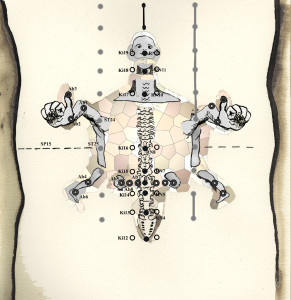An Introduction to Abdominal Acupuncture
By Dave Shipsey (B.Sc), Grad dip, C. Ac, A.Ac, Dip. Tuina, Dip. Buteyko Breathing M.A.F.P.A. M.B.B.A.
Introduction
Fig 1 Turtle Hologram used in Abdominal Acupuncture
Abdominal acupuncture (AA) is one of the newest and most exciting forms of acupuncture to evolve from China in decades, if not centuries. Abdominal acupuncture (Fuwas developed by
Dr. Bo ZhiYun and it has been in use since 1991.
It was discovered in 1972 as a result of a particularly difficult case of sciatica which did not respond to conventional or other microforms of acupuncture. When Dr. Bo tried using points (Qihai) Ren 6 and (Guanyuan) Ren 4 the back pain eased within minutes of starting treatment and the patient recovered completely without further treatment. Dr. Bo realised the potential of Abdominal acupuncture and dedicated the next 30 years of his life to developing and refining this system. It uses standard and new abdominal acupuncture points known as the Abdominal Meridian System (AMS).
AA is a micro-system of acupuncture and like other microforms such as Auricular acupuncture all the organs and body parts are contained within a small area. Unlike other Micro-systems AA is much more powerful as a result of its location with the zang fu organs and because it connects with all the meridians of the body (discussed later). It uses the Tortoise or Turtle as a blueprint (see fig 1) to reflect the anatomical location of the body parts at the superficial (Heaven) level. In a similar way that an image of an upside down foetus is used to map the points on the ear.
As a therapy it has become very popular in China because of its powerful results and its gentle nature (needle sensation). Indications include: orthopaedic problems, respiratory infections, coronary artery disease, hypertension, digestive problems, neurological conditions, gynaecological problems, and difficult-to-treat diseases like Parkinson’s, insomnia, depression, diabetes mellitus, eye diseases, obesity, deafness and tinnitus. It is particularly good for treating painful and chronic conditions and has proved to be very effective at treating conditions such as Haemaplegia from wind stroke. Results are often instantaneous and long lasting for these reasons it has become known as “Miracle Therapy”.
Special significance of the abdomen
The abdomen is energetically very important in Chinese medicine and has been written about in such ancient books as the “Neijing”. The abdomen includes the area known as the “Dantian” or “field of elixir”. This area is where our life force eminates from and is a focal point in most forms of Meditation, Qi Gong, Tai qi and other martial arts practices. In ancient times the abdomen was used more for diagnosis and the book the “Nan Jing” stated in chapter 8 that the abdomen was more diagnostically relevant than the pulse. Diagnosis using the abdomen requires a sensitivity that takes approximately 3 years to cultivate.
From the embryological stage Shenque Ren 8 forms the epicentre which regulates qi and blood flow of the body. It forms the core from which all other meridians in the body derive known as the Shenque system or AMS (Abdominal Meridian System). The AMS is a network of meridian acupoints governed by Shenque (Ren 8). As mentioned above, all the zang fu organs reside in this area and can be accessed either directly or through the AMS connection (the lungs and heart in the upper Jiao are connected with the abdomen via their internal external relationships with the large intestine and small intestine respectively). This explains some of the mechanisms by which AA works and how puncturing points on the abdomen can address disharmonies anywhere in the body. AA works on 3 levels Heaven, Humanity and Earth these are similar to, but different to the traditional acupuncture sequence.
• Heaven / superficial level, treats head, torso, upper and lower limbs. It is represented by the Turtle / tortoise.
• Humanity / middle layer connects the internal and external. Based on the Jing Luo theory and regulates the meridians.
• Earth / Deep level treats the Zang fu organs and is represented by the Ba Qua / 8 trigrams.
Abdominal Acupuncture Points and some indications;
Abdominal acupuncture is Bi dimensional in nature so that points on the Ren can be used to treat the Du mai and likewise points along the kidney channel can be used to treat the urinary bladder channel. It should be noted that point location is different with AA but for simplicity conventional location methods can be used. (See fig 1)
• Ren 12 (Zhongwan) Treats head , heart or lungs and also acts on 1st cervical vertebra
• Ren 11 (Jianli) Exerts its effect on the throat and neck and anatomically relates to the 1st Cervical vertebra.
• Ren 10 (Xiawan) treats spleen / stomach and relates to the 7th Cervical vertebra.
Ren 9 (Shuifen) is equivalent to the 7th thoracic vertebra
• Ren 6 (Qihai) activates the system brings Qi home, it coincides with the 1st Lumbar vertebra.
• Ren 4 (Guanyuan) Treats kidney and also brings qi home. It is the tail of the turtle relates to the 4th lumbar vertebra.
• St 25 (Tianshu) is the front mu of the Large Intestine and is used to clear heat and strengthen the back.
• Sp 15 (Daheng) is the outer boundary of the Turtle along the horizontal axis and treats spleen / damp conditions.
• St 24 (Huaroumen) and 26 (Wailing) can act as the 4 gates and also act as Shoulder and Hip points respectively.
• Upper rheumatism point is 0.5cun lateral and superior to shoulder and also acts as the elbow point.
• Lower rheumatism point is 0.5cun inferior and lateral to the hip points and also acts as knee points.
• Wrist points are 0.5 cun lateral and inferior to elbow points (so that the shoulder elbow and wrist look like an upside down V).
• The ankle point is on a line 0.5 cun lateral and inferior to the knee point. ( Hip, knee and ankle should look like a back slash )
• Kidney points between Kid 19 and Kid 13 are used bilaterally to treat equivalent points along the Urinary bladder or to strengthen the overall effect of the treatment.
Therapeutic effect is thus dependent on the location and depth of the needles, making it different from other forms of acupuncture. The depth of the needles ranges from very superficial 0.1cun to deep at 1.5cun.
Author’s experience & Case Histories
I have been practicing AA since I first studied it with Dr. Yan Han in 2000; I have practised it intently and am always amazed with the results that can be achieved with it. I return regularly to Nanjing to further my training and realise that it is only by trial and error and a willingness to explore different methods that one develops skill in this form. I use AA 90% of the time in my practice and I have only had 2 clients who did not prefer it as a therapy. I have used it for a multitude of conditions and most respond very well to it. Painful conditions are particularly good to treat as one can gauge the results instantaneously. I ask clients to put a maximum score of 10 on their pain before starting treatment. This is used as a reference point and as the needles are being inserted I check for changes on the pain level, usually clients will report pain down from 10 to 2 or even zero within minutes. Very slight adjustments of the needle depth or location can have a profound effect on the final result. Palpation of the abdomen to locate ahshi points is paramount and with sensitivity practitioners will feel anomalies relating to the area of pain and by needling these points and breaking down local adhesions the pain is resolved. Other diagnostic techniques involve looking at the overall condition, observing moles, colour changes shape of umbilicus and temperature changes to assist formulating patterns of disharmony.
Case Bob the Builder (name changed for confidentiality!) Age 38.
Bob had chronic pain due to a Slipped disc (T-3). He was prescribed Diaphene and was using Neurofen plus and other over the counter medication to try and control the pain. As a result of almost 18 months of medication he had spleen qi vacuity and kidney yang vacuity. He was nervous and didn’t want to have his back needled after a previous treatment with a physiotherapist. He had tried chiropractic and osteopathic therapy and had not responded to either.
Within minutes of starting the treatment the pain moved and after some fine tuning of the needles the pain had totally gone. He returned for his second session 4 days later and was delighted that he had not had to use any medication and was able to enjoy normal activities. He had a total of 7 treatments and was able to return to work.
I have clients who have had MRI scans before and after treatment. The scan results testified that discs had moved back into the correct position following a course of abdominal acupuncture.
Mary, a choreographer, dancer and actress.
Acute Sciatica
Mary hurt her back during rehearsals on the day of the opening night of a show. She complained of severe pain around L-4 with radiating pain down the U.B. channel to UB 57. She could barely walk let alone dance. Using AA her pain went within 5 minutes of needling and she was able to stand up straight and walk without any pain after the 45 minute session. She performed a very physical show that night and went on to complete the 6 week run of the show with only a couple more treatments.
Conclusion
Abdominal acupuncture is known as miracle therapy for good reason, it has continuously proven its therapeutic efficacy and there have been a number of studies done to endorse this. It has many advantages over other micro systems and it is particularly effective for treating clients with weaker constitutions. Clients prefer it because it is less painful and is often more effective than other forms of acupuncture. It is also safer as the needling tends to be more superficial. It can treat a wider variety of complaints (e.g. pain in all areas as a result of rheumatism etc.) in one treatment than other forms.
I will be running the next Centreforce abdominal acupuncture course, a 2 day workshop “mastering the art of abdominal acupuncture early in 2016. This course has been approved by the AFPA for 4 CPD points and by the ACI for 14 CPD points. Please send any enquiries to me at [email protected] or see www.dan-tien.ie/centreforce-acupuncture-courses/
Please note images are the property of Dave Shipsey and cannot be copied or used otherwise without permission


